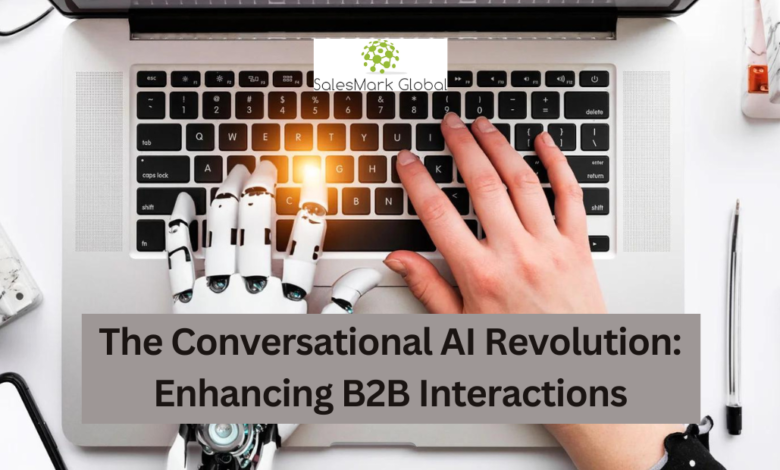The Conversational AI Revolution: Enhancing B2B Interactions

Digital transformation has swiftly transformed the B2B landscapes, making them highly tech-oriented in communications and tasks. Chatbots represent the greatest progress accomplished over the years. The article actively uncovers the necessity of conversational intelligent AI for ABM, the workings of the conversational AI-ABM Duo, and the optimal practices for conversational AI. The future of conversational intelligent AI in ABM is revealed.
1. AI in ABM
The ABM is gaining good accreditation as, instead of losing a large audience, it is aiming to tap into a few high-value accounts. Through its help, marketers can design their strategic marketing plans in the appliance of the target groups’ interests and choices. AI is taken on board by ABM programs so that marketing can be put on another level entirely. AI makes possible better client personalization, other-data analysis, and customer interaction sessions. One of the important aspects is that conversational AI is a specific kind of AI with which people in sales can have personalized conversations with prospective customers, which helps ABM orchestrate.
2. Approaches for Optimizing Great Customer Experience through the use of conversational AI and Enhanced Customer Experience Strategies.
To make the most of conversational AI in B2B settings, there are some smart strategies to follow:
2.1 Personalize Conversation
Each client is like a snowflake and it matters how we deal with them as individuals based on their peculiar needs and interests. The data you have on your clients is one of the factors that you can look at. Examples are what they’ve bought on their previous transactions and how they have engaged the chatbots for customer service agents. Conversational AI actively assumes a transformative role, delivering tailored solutions to various queries. Whether presented visually, vocally, or through text, it ensures all communication objectives are met. Due to this huge array of features, Conversational AI can enhance its speech and text-based input and replicate real human interaction, consequently making the conversational experience much more user-friendly.
Besides this, it makes it possible to search using different versions of languages, which in turn expands accessibility and ensures everyone is included irrespective of the language they use. A conversational AI will have the ability to analyze the intention, context and sentiment of users and thus will respond in a way that correlates to this. While these include spoken discussions, written conversations and multilingual interactions, conversations through artificial intelligence are on the verge of changing the way we communicate with a holistic solution. It brings trust and satisfaction to make a customer confident about their purchase.
2.2 Use Data Wisely
Through the integration of social listening into CRM systems marketers might be able to immediately grasp a great deal of crucial data about their customers. It means that customers will be able to have much more meaningful communication with chatbots which are already available. Through touchpoints, such as past purchases or communication history, the customer’s replies will be more accurate, and hence one can be assured. This leads to higher engagement among the customers, and their tendency to stay with the brand increases.
2.3 Keep Improving
From a CMO’s perspective, AI actively discerns inequities and directs marketing officers and sales managers to devise strategies. This allows for rapid identification of poor results and swift implementation of improvements. AI responds according to scripts, reacting even when it anticipates the outcome! To enhance AI’s performance over time, there’s an ongoing need for response evaluation, regular monitoring, and continuous improvements. The AI ensures that services provided are still good and not out of date, since clients’ needs may change as time goes by.
2.4 Have Humans Ready
People like to chat with a real person when they encounter difficulties; it is necessary to provide human support for complex queries. At times customers call to benefit from a human onboard that could assist them casting a shadow on the complicated questions and situations. Having your staff to be present during the peak or rush hours, will ensure customers are always dealt with professionally and at the highest level of service.
3. Future Trends and Advancements in Conversational AI
Practising these techniques enables firms to make the most of the engagements through conversational AI, simply by providing a more convenient, enhanced, and amicable customer experience and by creating intensive customer involvement.
3.1 Multimodal Interfaces
The capabilities of a computer, still in the developmental state, are fascinating, as they incorporate text, speech, and image. Through this integration, the user can also expect a chatbot that will be more meaningful and dynamic during interaction. To illustrate, one can give an example in which a human could frequently use voice recognition, typing as well as displaying images while conversing with an AI interface, hence providing more smoothness, naturalness, and intuitiveness to the conversation.
3.2 Emotional Intelligence
Looking ahead, forecasts suggest that conversational AI systems may struggle to match human perception and response to emotional elements in conversation. However, developing emotional intelligence in AI could give it the ability to interpret subtle speech tone cues and context, which its algorithm could then use to fine-tune responses. Injecting empathy into the conversations makes the AI chat conversation aware of the intricate need of humanity and the intensity of the problems the users encounter, consequently; the bond and rapport between the conversants go deeper.
3.3 Industry-Specific Solutions
Moreover, a growing backbone of more conversational AI platforms that are for niche industries is to be seen. It could no longer be a trend for AI systems to develop generic chatbot programs; instead, business AI will be more customized to solve specific problems in each industry like healthcare, finance, and retail, respectively. The specified innovations will harness the committee-specific data and processes to offer more focused and top-quality support which in turn will lead to improved performance and productivity within companies.
The future of conversational AI is limitless as rising multimodal interfaces, which make emotional intelligence, and context-sensitive solutions will modify the very opinion on how we are talking to AI systems. As a consequence, such trends, if embraced by organizations on a large scale, would lead to more human-friendly conversations, checks, and balances between technology and its users.
Conclusion
We anticipate that conversational AI technology will actively foster opportunities for other industries, empowering them to adapt the technology to their specific needs and provide unique, customized user experiences. For instance, the healthcare industry employs conversational AI to respond to patient queries and schedule appointments. Meanwhile, finance wholesale activities leverage conversations AI to offer individualized pecuniary advice and digital banking among many other activities. Furthermore, natural language processing is the key technology that the conversational AI leads marketing and sales force, such as customer service, product recommendations, and so on. Along with enhanced involvement of usage technologies, an adaptation of business industry sets of solutions will arise that will benefit the performance of departments and realign relations with customers and business owners.
For more interesting content visit



